On June 5, 1989, an unidentified man stood in front of a row of tanks near Beijing's Tiananmen Square — and became world-renowned as the "Tank Man."
On June 4, 1989, the Chinese government ordered the military to suppress a pro-democracy protest in Tiananmen Square in Beijing, resulting in untold deaths and injuries. Tragically, estimates of the casualties that day have ranged from several hundreds to several thousands.
One day after the massacre, a lone protester, now known as “Tank Man” or the “Unknown Rebel,” courageously stood in front of a column of Chinese military tanks, blocking their path in an iconic act of defiance.
Tank Man’s bravery, captured by multiple photographers, soon became an enduring symbol of resistance against authoritarianism. Despite multiple attempts by the tanks to maneuver around the Unknown Rebel, the man continued to stand his ground before being forcibly removed by two other men. To this day, Tank Man’s identity and fate remain a mystery.
Though the Chinese government has effectively banned discussions about the Tiananmen Square massacre and Tank Man, dissidents and artists around the world have kept the memory alive. The enduring image of the Unknown Rebel continues to inspire those who resist oppression, with artistic tributes to Tank Man symbolizing the resilience of the human spirit.
Inside The Brutal Tiananmen Square Massacre
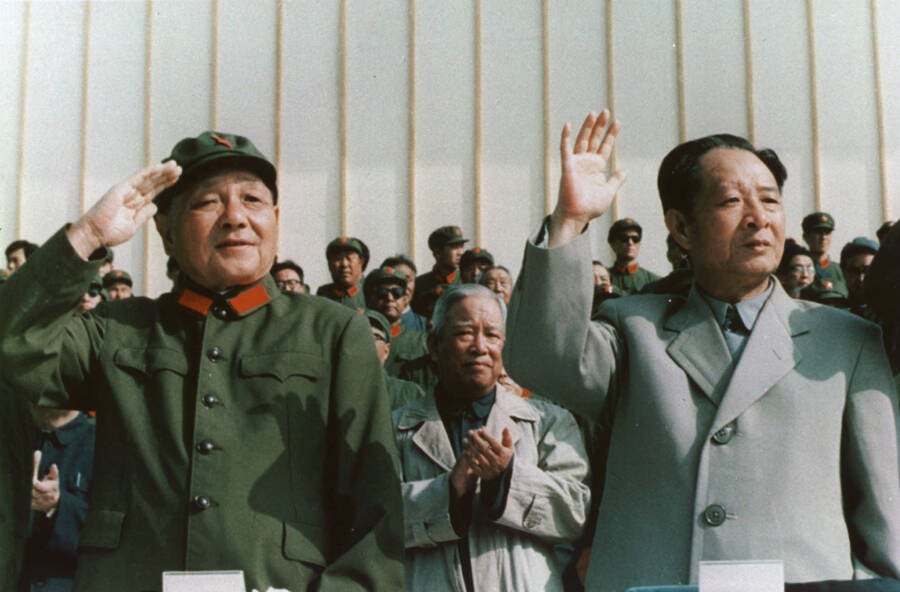
XinhuaChinese leader Deng Xiaoping (left) and Communist Party chief Hu Yaobang (right) in 1981. Hu Yaobang’s death would inspire the pro-democracy protests in Tiananmen Square.
By April 1989, civil unrest in China was close to a breaking point. From 1978 to 1989, China’s preeminent leader Deng Xiaoping had guided China toward massive economic development. Under his leadership, China had transformed into a socialist market economy with Special Economic Zones (SEZ), where free market trade was allowed and government regulation was more relaxed. These changes inspired young Chinese students and professionals to take stronger positions in support of democratization.
Then, in mid-April 1989, Hu Yaobang, a general secretary in the ruling Chinese Communist Party (CCP) who was known for his liberalism and for being a staunch supporter of reforms within the notoriously corrupt government, died of complications from a heart attack. His death cemented him as a martyr for thousands of pro-democracy civilians and students across China who protested the communist government’s regime, and in his wake, huge student protests eventually broke out at Beijing’s Tiananmen Square.
In response, the government implemented martial law in Beijing.
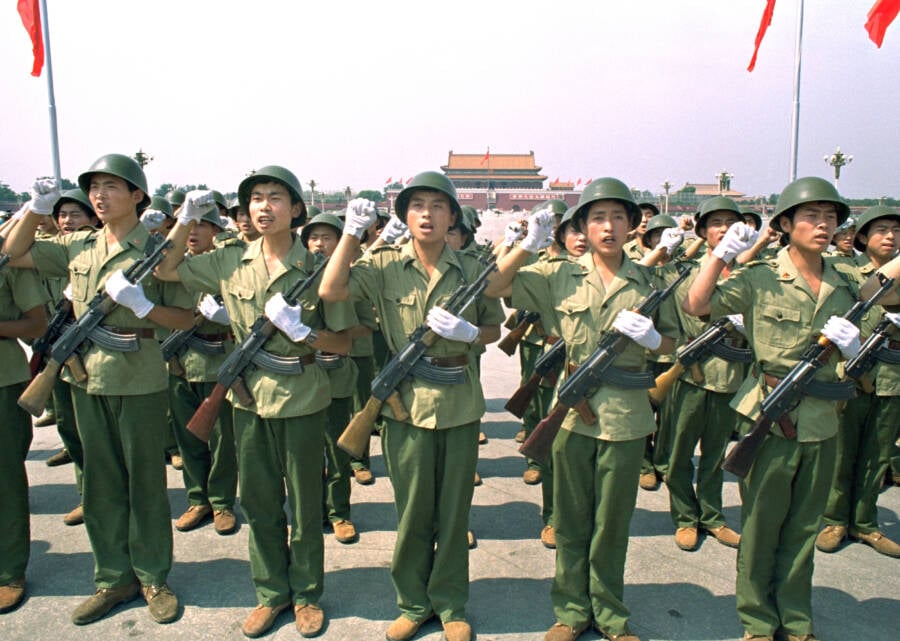
Richard Ellis/Alamy Stock PhotoPeople’s Liberation Army soldiers take an oath to the communist party in Beijing’s Tiananmen Square on July 2, 1989.
The protests at Tiananmen Square escalated in the early hours of June 4, 1989, when troops arrived to establish control over the students.
Protesters were allegedly given a warning to vacate the square, but many decided to stay and continue their demonstration. Some even began throwing rocks and other objects at soldiers. Troops responded by opening fire on protesters and attacking them with batons and even tanks, which reportedly crushed some of the demonstrators to death.

Stuart Franklin via WikimediaChinese tanks advance near Tiananmen Square — moments before their encounter with the Tank Man.
A number of protesters threw Molotov cocktails in self-defense and set fire to military equipment. Some reports say that some protesters beat People’s Liberation Army (PLA) soldiers to death during the protests.
The violence was ugly, to say the least.
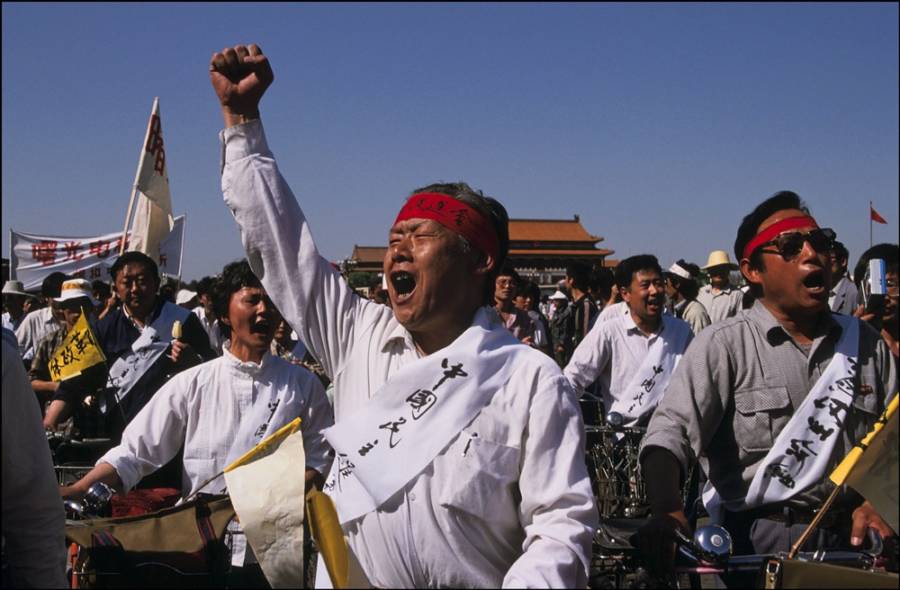
Chip HIRES/Gamma-Rapho/Getty ImagesProtesters gathering at Tiananmen Square in Beijing.
It’s difficult to say exactly how many were killed, injured, or detained during the protests because China has censored most of the information related to the crackdown at Tiananmen Square, but United Press International reported in the days following the massacre that the government initially claimed there were 300 deaths — including 100 soldiers. But this tally was later lowered to 200. According to the Chinese Red Cross at the time, there were an estimated 2,600 deaths, but this number was also later withdrawn.
Meanwhile, a secret diplomatic cable from Sir Alan Donald, then the British ambassador to China, estimated that at least 10,000 were killed at the protests between June 3rd and 4th. (This cable was declassified in 2017.)
Following the chaos, the CCP arrested thousands of protesters in Tiananmen Square and even executed some of them. Still, some voices refused to be restrained by the government, and so the memory of the tragedy at Tiananmen Square lives on — especially in the image of Tank Man.
Tiananmen Square’s Famous Tank Man
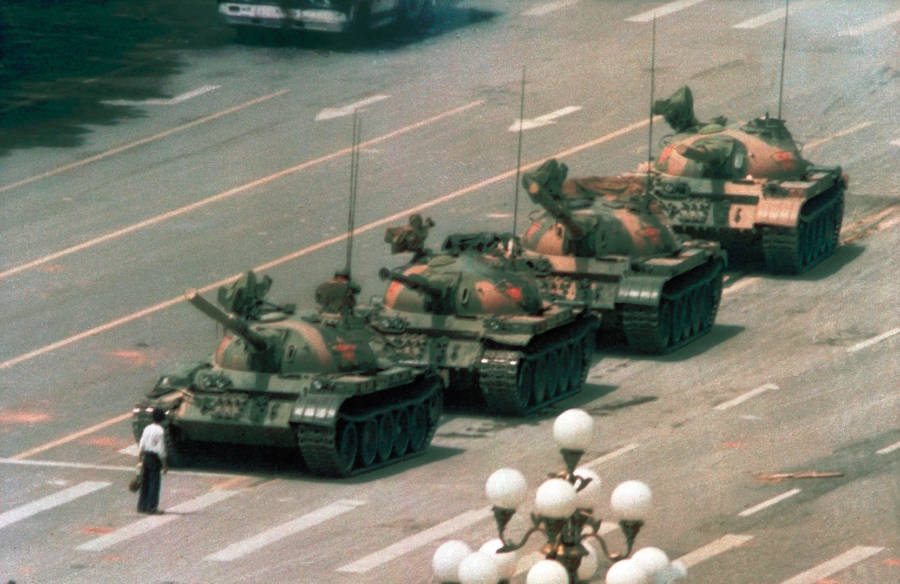
Wikimedia CommonsThis photograph of Tank Man, or the Unknown Rebel, has encapsulated the spirit of the protests at Tiananmen Square.
There are many striking images of the brutality on display during and after the Tiananmen Square massacre, but one scene stands out above the rest.
On June 5th, a day after the bloody clash between Chinese troops and protesters, an unbelievable encounter occurred. As a column of Chinese military tanks began to line the streets, an unidentified protester, only known now as Tank Man, walked into the middle of the vehicles’ path.
The man was unarmed and appeared to be carrying shopping bags. Once the moving tanks reached a complete stop in front of him, Tank Man waved his hand, as if to tell the vehicles to turn back. At one point, the Unknown Rebel even climbed atop one tank and talked with the crew inside before lowering himself back down to the ground. The tanks tried to maneuver around the man, but he merely moved to continue blocking their path.
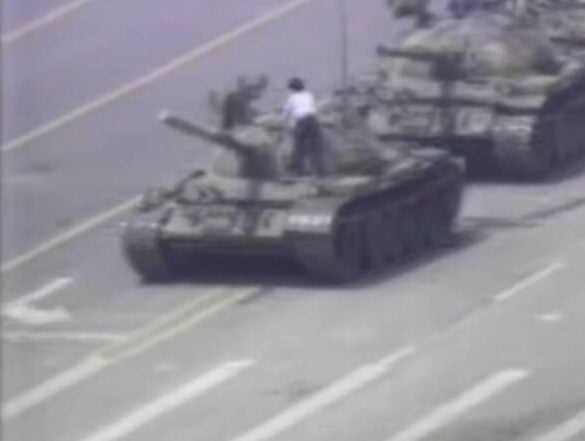
CBS NewsA snapshot of Tank Man, or the Unknown Rebel, standing on the tank.
Eventually, two unidentified men grabbed Tank Man and pulled him out of sight, never to be seen again. No one is sure whether the individuals who grabbed him were civilians or government officials.
The highly dangerous exchange went on for about five minutes and was captured on camera by several journalists, but it was the image captured by photographer Jeff Widener that became the most famous.
Widener had been called up to Beijing by the Associated Press to photograph the massive protests happening at Tiananmen Square. It was his first time on an assignment that involved documenting so much violence, and he was nervous about what to expect. His fears were quickly justified; after getting caught in a conflict between soldiers and protesters, he suffered a blow to the head from a lump of concrete while taking photos.
He went back to the AP office to recuperate and almost talked himself out of going back to shoot more photos. What he saw had already horrified him: burning cars, students with guns, a dead soldier, and a man lit on fire. To top it off, he also had developed the flu and one of his cameras had broken.
“I was shutting down,” Jeff Widener later recalled in an interview with the Observer. “I had the feeling if I went back I’d die.”
But the next day, Widener decided to go back out there again. His bosses had requested images of the army’s occupation of the square, so Widener rode a bicycle to the Beijing Hotel, where he could get a good vantage point from one of the balconies. Of course, he needed access to a room.
Luckily, he spotted an American exchange student named Kirk Martsen and asked him for permission to use his balcony. The student agreed, but by the time they got to the room, Widener realized that he was out of film. Fortunately, he managed to get a fresh roll with help from Martsen.
Soon, the noise of tanks caught Widener’s ear. He looked outside and saw the line of military vehicles driving near the square. Then, he saw Tank Man.
“At first, I’m thinking this guy is going to screw up my composition. But the student is shouting: they’re gonna kill him, they’re gonna kill him!” Widener remembered. “He’s just standing there. I’m watching, watching, watching.”
For a split second, Widener left the balcony to get a teleconverter, which could produce a better long-distance shot. He managed to snap three quick photos before the two unknown men came and took the protester away.
“I noticed there was a problem with my camera. It was too slow a shutter speed,” Widener told NTD. “I thought, ‘Oh my God, I lost the picture.’ But miraculously, one picture came out, and that went to the rest of the world.”
To this day, the identity of the man who faced down the tanks remains unknown, but Widener believes that someone in the Chinese government knows exactly who he is. Chinese government officials have long denied knowing the identity of Tank Man or what happened to him, but rumors of his imprisonment, execution, or escape from China still circulate today.
Widener has since gone on to cover stories all over the world, but his photo of the heroic Unknown Rebel has stayed with him through the years.
“I live with it every day,” he said. The photo of Tank Man and his defiance against the Chinese regime is still heralded as a powerful representation of resistance against totalitarianism — and TIME even named the picture of the Unknown Rebel as one of the most influential images of all time.
How Chinese Dissidents Have Spoken Out Since The 1989 Tiananmen Square Protests
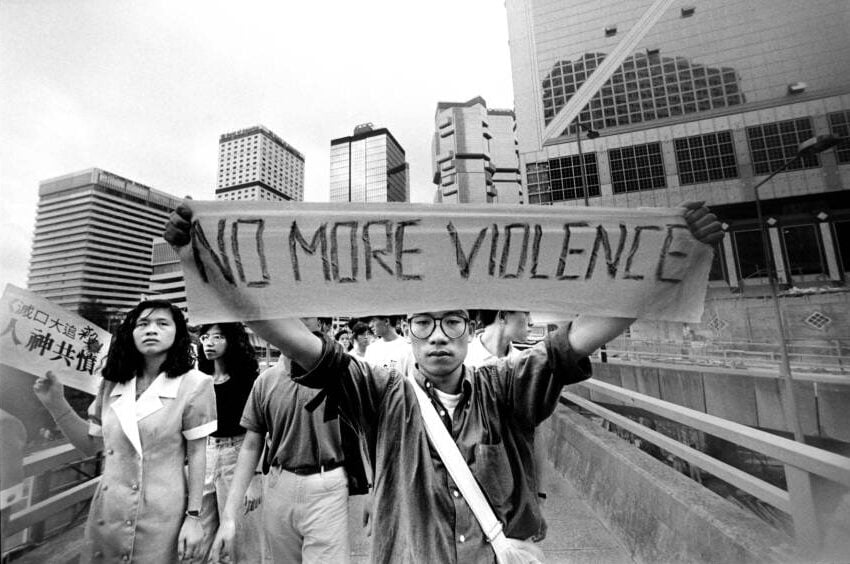
Brian Harris/Alamy Stock PhotoProtests in Hong Kong two days after the massacre in Beijing’s Tiananmen Square. June 1989.
Years after the tragedy, the Communist Party of China still forbids discussion about the Tiananmen Square massacre. Media — including books, art, and films — concerning the incident is banned. Those who dare to speak of or mention the atrocities are censored and even imprisoned.
The Chinese government has never issued an apology to the victims’ families either. Many officials act as if the killings never happened, and those who do acknowledge them say the response to the protests was the “correct policy.”
But everyone who was there certainly remembers the truth. Over the years, there has been a growing number of Chinese dissidents who speak out against the Chinese government’s hand in the bloody massacre of protesters and ensure that those who died that day are not forgotten.
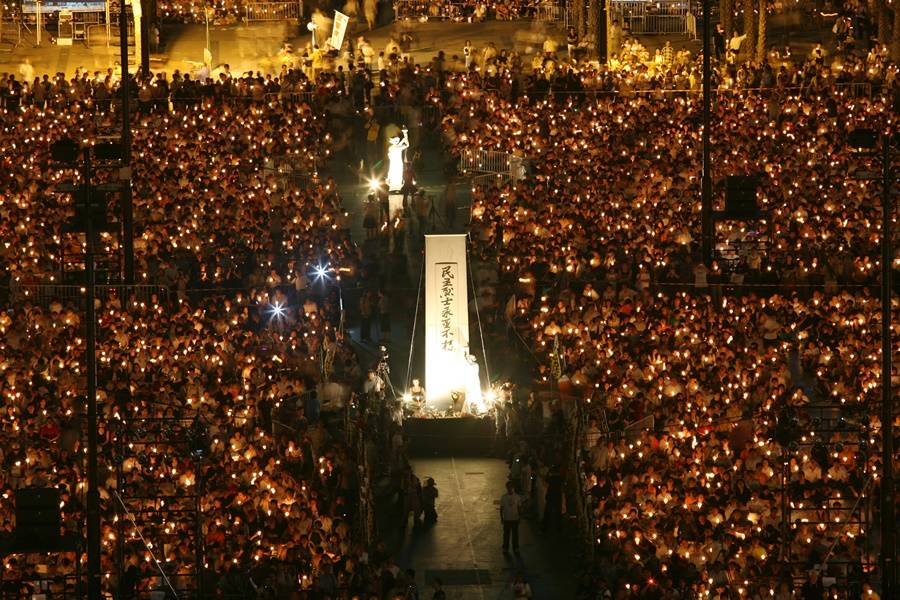
Martin Chan/South China Morning Post/Getty ImagesA candlelight vigil for Tiananmen Square victims in Hong Kong in 2009.
In 2019, former People’s Liberation Army journalist Jiang Lin spoke out after she left China about the gruesome violence she saw and experienced first-hand during the Tiananmen Square protests. Amidst the massacre, Jiang had swapped her military uniform for civilian clothing and headed to the square, where she was eventually brutally beaten by police officers.
The violence left both physical and emotional wounds on Jiang.
“It felt like watching my own mother being raped,” Jiang remembered in an interview with The New York Times. “It was unbearable.”

Independent/Alamy Stock PhotoSenior People’s Liberation Army officers hang photographs of their comrades who were killed amidst the protests in a makeshift memorial near Tiananmen Square.
As more and more dissidents speak out, the image of Tiananmen Square’s Tank Man has remained a spark that ignites the will of others to make their voices heard. The desire to dissent against the Chinese government is particularly common among Chinese artists, many of whom have fled the country so that they can express themselves more freely.
A Taiwanese artist known as Shake wants people to remember that day through the artwork she creates. One of her 2019 pieces was a recreation of the Tiananmen Square Tank Man encounter using giant inflatables.
“I think it is important to the Taiwanese people to continue discussing this topic — preventing people from forgetting this event and reminding the Taiwanese people that the regime in China is dangerous,” she said of her artwork, which went on display in Taipei, by the Chiang Kai-shek Memorial Hall, to mark the 30th anniversary of the Tiananmen Square massacre.
Despite the world not knowing his name — or what happened to him — Tank Man is almost universally recognized as a symbol of resistance.
“A lot of people see their trials and tribulations in life summed up in this man,” photographer Jeff Widener said of his most famous subject’s legacy. “I think Tank Man represents everyone’s challenge in life.”
After this look at the legendary Tiananmen Square Tank Man, check out the untold story of Witold Pilecki, the man who voluntarily entered Auschwitz to expose its horrors to the world. Then, take a look at these 33 photos from the My Lai massacre, the war crime the United States got away with.






